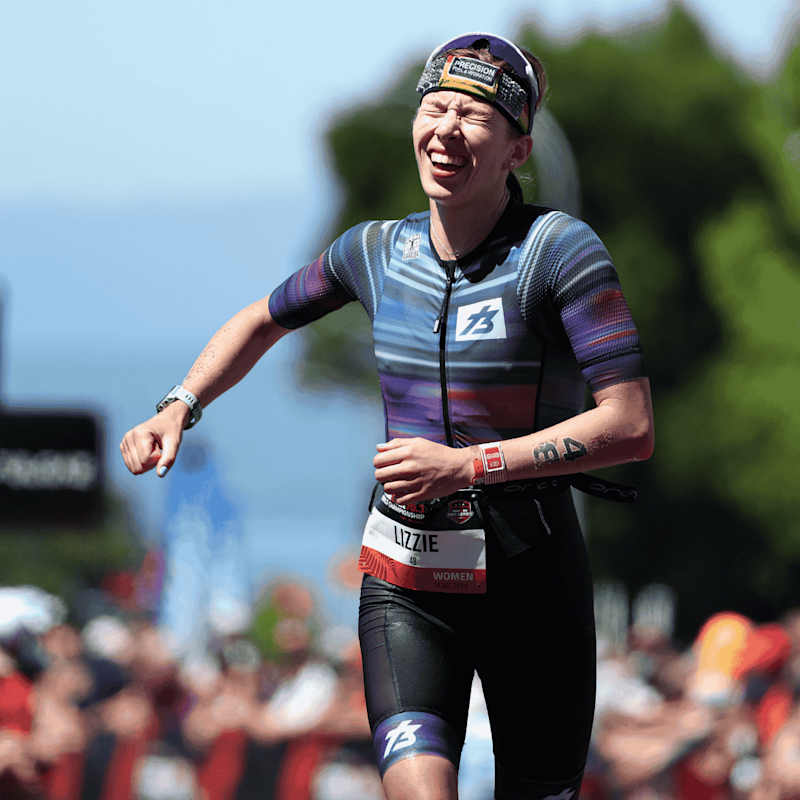
Lizzie Rayner
IRONMAN 70.3® Portugal-Cascais
Lizzie's headline numbers
Lizzie's strategy
Fueling
Carbohydrate is the main fuel you burn when racing. Failing to fuel properly is a leading cause of underperformance in longer races.
A year on from her first IRONMAN 70.3® Portugal-Cascais win, Lizzie returned to successfully defend her title in a faster time with the help of a refined fueling strategy. Compared to ~78g of carbohydrate per hour across the race in 2024, she increased her average carb intake by ~27g/h to average over ~100g/h - her highest ever intake across a 70.3® race. To do this, she changed her strategy from previous races by swapping out her usual bike bottle of PF Carb Only Drink Mix for ~200g of carb from PF 300 Flow Gel mixed into a bottle. Adjusting her product use tactically meant she was able to take on ~10g/h more carbs on the bike alone compared to her last 70.3® race in Aix-en-Provence. Her higher, and consistent carb intake provided her with a steady stream of energy to maintain a high intensity across the day without any stomach issues, testament to her gut training over the last year.
Hydration
Taking on board an appropriate amount of fluid and sodium is essential to maintaining blood volume and supporting the cardiovascular effort needed to perform on race day.
Whilst the absolute amount of sodium and fluid consumed per hour is important, it’s critical to consider these in relation to each other. This is known as 'relative sodium concentration' and it’s expressed in milligrams per litre (mg/L). How much sodium you’re taking in per litre of fluid is more important than the absolute amount taken in per hour.
Sweat sodium concentration (mg/L) is largely genetically determined and remains relatively stable. Knowing how salty your sweat is enables you to replace a good proportion of your sweat losses, which can range from 200-2,000mg/L.
Whilst Lizzie’s losses are on the moderate side, getting her hydration strategy right is still crucial when it’s hot and/or humid as her higher sweat rate in these conditions can result in significant net losses over the duration of a race.
Learn moreIn very similar environmental conditions as last year, Lizzie took on slightly more fluid across the race, using a mix of PH 1000, PH 1500 and water to achieve a relative sodium concentration that closely matches her sweat sodium concentration to maintain fluid and electrolyte balance. But, her total fluid intake was slightly lower than in recent races, partly due to switching from Carb Only Drink Mix to PF 300 Flow Gel and struggling to get much out of the small aid station cups on the run. She reported some mild cramping towards the end of the bike and on the downhills during the run. Whilst this could be down to multiple factors, she may benefit from being even more proactive with her fluid replacement and collecting further sweat rate data at race intensity during training to make sure a deficit between her losses and intake isn’t playing a part in these twinges.
Caffeine
Beyond the Three Levers of Performance (carb, sodium and fluid), caffeine is one of only a few substances that is proven to improve performance for most endurance athletes as it can help stave off mental and physical fatigue.
Lizzie once again implemented her trusted and consistent caffeine dosing and timing for middle-distance races; one pre-race coffee, a PF 30 Caffeine Gel before the swim and another on the bike. This suits her individual tolerance to the supplement whilst meeting the minimum effective dose found to elicit performance-enhancing effects.
How Lizzie hit her numbers
Here's everything that Lizzie ate and drank on the day...
Lizzie's weapons of choice
Final thoughts
Lizzie's full stats
Data Confidence?
There is good confidence in the accuracy of the data reported. An athlete feels that the numbers closely reflect what they consumed despite a couple of estimations which may carry some degree of error. The majority of what was consumed is recorded to a high level of specificity (most volumes are known through the use of bottles brands quantities flavours). The numbers are very plausible and align with previous data recordings (if an athlete has collected data previously).